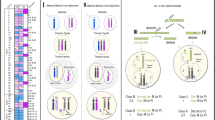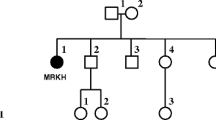Summary
A case of Prader-Willi syndrome (PWS) associated with a de novo unbalanced 15q;17q reciprocal translocation presumptively resulting from the tertiary monosomic form of 3:1 meiotic disjunction is described. Twenty-three similar unbalanced translocations have been identified from the literature. The 24 karyotypes are characterised by having 45 chromosomes, monosomy for the pericentromeric region of chromosome 15 (range pter»q11 to q21), and little monosomy of the recipient (non-15) chromosome. Two-thirds of the cases with these karyotypes have phenotypic features of PWS. It seems probable that (i) where unbalanced reciprocal translocations are associated with PWS, they will almost invariably be presumptive segregants of the tertiary monosomic form of 3:1 disjunction and (ii) the majority of cases found with this type of karyotype, particularly it appears when de novo in origin, will be associated with phenotypic features of PWS.
Similar content being viewed by others
References
Aula P, Karjalainen O (1973) Prenatal karyotype analysis in high risk families. Ann Clin Res 5:142–148
Berry AC, Whittingham AJ, Neville BGR (1981) Chromosome 15 in floppy infants. Arch Dis Childh 56:882–885
Bonuccelli CM, Stetten G, Levitt RC, Levin LS, Pyeritz RE (1982) Prader-Willi syndrome associated with an interstitial deletion of chromosome 15. Johns Hopkins Med J 151:237–242
Borgaonkar DS (1973) A (15;18) translocation, unbalanced, 45 chromosomes. Cytogenet Cell Genet 12:370–371
Borgaonkar DS, Ebenezer L, Scott CI, Golob HM, Bahr GF (1973) Identification of a D/E (15/18) translocation chromosome by quinacrine fluorescence and urea banding techniques. Humangenetik 17:317–321
Butler MG, Kaler SG, Yu P, Meaney FJ (1982) Metacarpophalangeal pattern profile analysis in Prader-Willi syndrome. Clin Genet 22:315–320
Cassidy SB, Holm VA, Thuline HC (1981) Does chromosome 15 proximal long arm deletion predict Prader-Willi syndrome. Clin Res 29:114A
Cavalli IJ, Sbalqueiro IJ, Wajntal A, Freire-Maia N (1982) A 15/17 translocation in a patient with Prader-Labhart-Willi syndrome. Hum Hered 32:149–151
Charrow J, Balkin N, Cohen MM (1983) Translocations in Prader-Willi syndrome. Clin Genet 23:304–307
Duckett DP (1982) Proximal 15q monosomy. J Med Genet 19:393–394
Duckett DP, Roberts SH (1981) Adjacent 2 meiotic disjunction. Report of a case resulting from a familial 13q;15q balanced reciprocal translocation and review of the literature. Hum Genet 58:377–386
Engel W, Vogel W, Reinwein H (1971) autoradiographische Untersuchungen an einer X-Autosomentranslokation beim Menschen: 45,X,15-,tan(15qXq+)+. Cytogenetics 10:87–98
Fraccaro M, Zuffardi O, Bühler E (1979) Deficiencies involving the paracentromeric regions of chromosome 15: Prader-Willi or a new syndrome? In: Tolksdorf M, Spranger J (eds) Klinische Genetik in der Pediatrie. Thieme, Stuttgart, pp 33–38
Guanti G (1980) A new case of rearrangement of chromosome 15 associated with Prader-Willi syndrome. Clin Genet 17:423–427
Hawkey CJ, Smithies A (1976) The Prader-Willi syndrome with a 15/15 translocation. Case report and review of the literature. J Med Genet 13:152–163
ISCN (1978) An International System for Human Cytogenetic Nomenclature (1978). Birth Defects XIV:8
Jalbert P, Sele B (1979) Factors predisposing to adjacent 2 and 3:1 disjunctions: study of 161 human reciprocal translocations. J Med Genet 16:467–478
Jalbert P, Sele B, Jalbert H (1980) Reciprocal translocations: a way to predict the mode of imbalanced segregation by pachytenediagram drawing. A study of 151 human translocations. Hum Genet 55:209–222
Kawashima H (1979) Cited as personal communication in: Fujita H, Sakamoto Y, Hamamoto Y (1980) An extra idic(15p)(q11) chromosome in Prader-Willi syndrome. Hum Genet 55:409–411
Kousseff BG (1982) The cytogenetic controversy in the Prader-Labhart-Willi syndrome. Am J Med Genet 13:431–439
Kučerová M, Straková M, Polívková Z (1979) The Prader-Willi syndrome with a 15/3 translocation. J Med Genet 16:234–235
Ledbetter DH, Riccardi VM, Airhart SD, Strobel RJ, Keenan BS, Crawford JD (1981) Deletions of chromosome 15 as a cause of the Prader-Willi syndrome. N Engl J Med 304:325–329
Ledbetter DH, Mascarello JT, Riccardi VM, Harper VD, Airhart SD, Strobel RJ (1982) Chromosome 15 abnormalities and the Prader-Willi syndrome: a follow-up report of 40 cases. Am J Hum Genet 34:278–285
Leisti J (1971) Structural variation in human mitotic chromosomes. Ann Acad Sci Fenn A IV Biol 179
Lindenbaum RH, Bobrow M (1975) Reciprocal translocations in man. 3:1 meiotic disjunction resulting in 47- or 45-chromosome off-spring. J Med Genet 12:29–43
Mattei JF, Mattei MG, Giraud F (1983) Prader-Willi syndrome and chromosome 15. A study of 20 cases. In: European Society of Human Genetics Symposium Autosomal Heterozygosity (Abstracts). Nijmegen, The Netherlands, 25–28 May, 1983. University of Nijmegen, The Netherlands, p 49
Mikkelsen M, Dyggve H, Poulsen H (1973) (6;15) translocation with loss of chromosome material in the patient and various chromosome aberrations in family members. Humangenetik 18:195–202
Ming PML, Goodner DM, Park TS (1977) Chromosome 6/15 translocation with multiple congenital anomalies. Obstet Gynecol 49:251–253
Morić-Petrović S, Laća Z, Krstić A, Živkov M (1981) A new case of Prader-Willi syndrome with chromosomal aberration. J Med Genet 18:481–483
Paris Conference (1971) Standardization in Human Cytogenetics (1972). Birth Defects VIII:7
Prescott GH, McCaw BK, Tolby BE, Hecht F, Miller RC, Greene AE, Coriell LL (1975) A (1:15) translocation, balanced, 46 chromosomes. Cytogenet Cell Genet 14:84–85
Rieger R, Michaelis A, Green MM (1976) Glossary of genetics and cytogenetics (4th edn), Springer, New York
Schwanitz G, Reither M, Grosse G, Hägele Ch, Grosse KP, Gutfried U (1975a) Partial monosomy 13 as the result of a balanced translocation 3/13 pat. Humangenetik 28:93–96
Schwanitz G, Reither M, Grosse G, Hägele Ch, Grosse KP, Gutfried U (1975b) Partial monosomy 13 as the result of a balanced translocation 3/13 pat. Humangenetik 29:354
Smith A, den Dulk G (1982) A severely retarded male with deletion of chromosomes 15 (pter»q13) and 10(q26»qter). J Med Genet 19:77
Stene J, Stengel-Rutkowski S (1982) Genetic risks for familial reciprocal translocations with special emphasis on those leading to 9p, 10p and 12p trisomies. Ann Hum Genet 46:41–74
Styles SM, Popkin JS (1981) Proximal 15q13»cen»15p deletion causing partial Prader-Willi syndrome (PPWS). Am J Hum Genet 33:123A
Townes PL, Ziegler NA (1965) D/E (13–15/17–18) translocation: occurrence in an infant with 45 chromosomes. Am J Dis Child 110: 686–688
Townes PL, White MR (1975) Further identification of a D/E translocation. Am J Dis Child 129:959–961
Wulfsberg EA, Klisak IJ, Sparkes RS (1981) Chromosome 15q interstitial deletions in the Rubinstein-Taybi syndrome. Am J Hum Genet 33:127A
Wulfsberg EA, Sparkes RS, Klisak IJ, Gurfield WB (1982) A 15»1 translocation in a patient mosaic for presence or absence of an isodic (15p)(q11). Am J Med Genet 13:417–421
Wyandt HE, Magenis RE, Hecht F (1977) Abnormal chromosomes 14 and 15 in abortions, syndromes, and malignancy. In: Yunis JJ (ed) New chromosomal syndromes. Academic Press, New York San Francisco London, p 301–338
Zuffardi O, Bühler EM, Fraccaro M (1978) Chromosome 15 and Prader-Willi syndrome (Abstract). Clin Genet 14:315–316
References
Cassidy SB, Thuline HC, Holm VA (1984) Deletion of chromosome 15(q11–13) in a Prader-Labhart-Willi syndrome clinic population. Am J Med Genet 17:485–495
Fraccaro M, Zuffardi O, Bühler E, Schinzel A, Simoni G, Witkowski R, Bonifaci E, Caufin D, Cignacco G, Delendi N, Gargantini L, Losanowa T, Marca L, Ullrich E, Vigi V (1983) Deficiency, transposition, and duplication of one 15q region may be alternatively associated with Prader-Willi (or a similar) syndrome. Analysis of seven cases after varying ascertainment. Hum Genet 64:388–394
Pauli RM, Meisner LF, Szmanda RJ (1983) ‘Expanded’ Prader-Willi syndrome in a boy with an unusual 15q deletion. Am J Dis Child 137:1087–1089
Smith A, Murray R, den Dulk G (1983) Familial deletion. Ann Genet (Paris) 26:91–93
Author information
Authors and Affiliations
Rights and permissions
About this article
Cite this article
Duckett, D.P., Roberts, S.H. & Davies, P. Unbalanced reciprocal translocations in cases of Prader-Willi syndrome. Hum Genet 67, 156–161 (1984). https://doi.org/10.1007/BF00272991
Received:
Issue Date:
DOI: https://doi.org/10.1007/BF00272991




